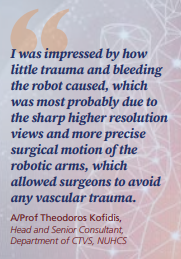Robots: Surgical Helping Hand
Robots help NUHCS surgical team achieve better outcomes
PULSE Issue 39 | June 2022
On 18 Jan 2022, robots joined forces
with the surgical team of cardiac
and thoracic surgeons and nurses at
the National University Heart Centre,
Singapore (NUHCS) to perform a
minimally invasive heart surgery,
carrying out a successful Internal
Mammary Artery (IMA) harvest
– the first robot-assisted bypass
surgery in Singapore.
The team from the Department
of Cardiac, Thoracic and Vascular Surgery (CTVS) consisting of Dr Chang Guohao, Consultant, Ms
Peggy Hu, Senior Case Management
Officer, and Ms Corina Lau, Nurse
Clinician, coordinated this case with
the support of Dr Harish Mithiran
Muthiah, Senior Consultant, and Dr Lowell Leow Choong Kiat, Associate
Consultant.
Robot-assisted bypass surgery has
been advancing around the world,
with even newer technologies arising. One of the key reasons why
many advanced heart centres in the
world are shifting their model of
care to include robots is due to positive reports of such surgeries, including reducing patients’ hospitalisation stay for recovery to an average
of just three days, even for major
surgeries like the Coronary Artery Bypass
Graft (CABG).
 There are many clear advantages for
robot-assisted surgery. Robot arms
are as thin as rods and needles which
means that these surgeries only
need much smaller cuts – down to
the millimetre – to access inner parts
of the body. This causes less trauma
to patients thus, translating to an
overall quicker recovery process.
These advanced robotic systems
are mostly equipped with sharp,
high-resolution cameras that provide
three-dimensional visualisation
of the internal body. The images
that show up on the screen can be
further magnified many times over,
allowing the surgeons controlling
the robots to make very precise cuts.
This feature helps to prevent the
straining of surgeons' eyes and
allows them to perform more
complex surgeries with ease.
Another key advantage of
the robot is its precision in
graft harvesting – a
widely used technique to reduce
post-surgery
wound
complications from heart operations. The robot has a wide
range of motion which allows the
surgeon to skeletonise the left IMA
and right IMA with more ease.
With robots, the surgical team
would have better accessibility to
both mammary arteries, further
providing the option to perform
a minimally invasive Total Arterial
Revascularisation (TAR) procedure.
Working with the advice and guidance of renowned experts – Dr
Gianluca Torregrossa, Director of
Robotic and Coronary Revascularization Program at the Lankenau Heart
Institute in Philadephia, the United
States of America (U.S.A.) as well
as Prof Husam H Balkhy, Director
of Robotic and Minimally Invasive
Cardiac Surgery, the University of
Chicago Medicine in Chicago, U.S.A.
– the NUHCS team hopes to achieve
results such as an average hospitalisation of just one to three days, similar to reports from renowned
specialised cardiac centres
around the world.
There are many clear advantages for
robot-assisted surgery. Robot arms
are as thin as rods and needles which
means that these surgeries only
need much smaller cuts – down to
the millimetre – to access inner parts
of the body. This causes less trauma
to patients thus, translating to an
overall quicker recovery process.
These advanced robotic systems
are mostly equipped with sharp,
high-resolution cameras that provide
three-dimensional visualisation
of the internal body. The images
that show up on the screen can be
further magnified many times over,
allowing the surgeons controlling
the robots to make very precise cuts.
This feature helps to prevent the
straining of surgeons' eyes and
allows them to perform more
complex surgeries with ease.
Another key advantage of
the robot is its precision in
graft harvesting – a
widely used technique to reduce
post-surgery
wound
complications from heart operations. The robot has a wide
range of motion which allows the
surgeon to skeletonise the left IMA
and right IMA with more ease.
With robots, the surgical team
would have better accessibility to
both mammary arteries, further
providing the option to perform
a minimally invasive Total Arterial
Revascularisation (TAR) procedure.
Working with the advice and guidance of renowned experts – Dr
Gianluca Torregrossa, Director of
Robotic and Coronary Revascularization Program at the Lankenau Heart
Institute in Philadephia, the United
States of America (U.S.A.) as well
as Prof Husam H Balkhy, Director
of Robotic and Minimally Invasive
Cardiac Surgery, the University of
Chicago Medicine in Chicago, U.S.A.
– the NUHCS team hopes to achieve
results such as an average hospitalisation of just one to three days, similar to reports from renowned
specialised cardiac centres
around the world.
